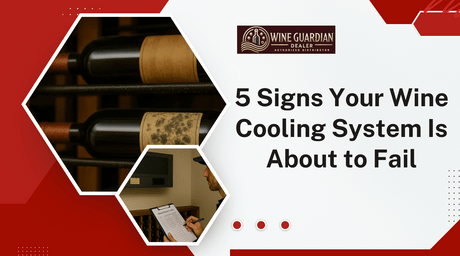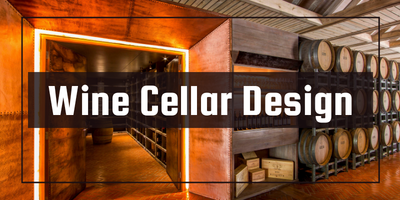
5 Signs Your Wine Cooling System Is About to Fail
Don’t wait for a costly surprise. Wine Guardian Dealer breaks down the top 5 signs your wine cooling system may be failing — and how to fix it before damage...
Jim Hopper
In Stock & Ready to Ship – Order Your Wine Cooling System Today!
Free Wine Cellar Expert Consultation | 📞 Call 1-800-260-1712
Start with a free expert consult—cooling system sizing, racking options, and no upsells.

Build your dream wine cellar—without costly mistakes or guesswork.
By Jim Hopper, Wine Cooling Expert

If you’ve got a large wine cellar—or you’re planning to build one—you already know it’s more than just racks and bottles. It’s a long-term investment in wine, design, and experience. Cellar cooling systems protect wine investments and improve taste once uncorked.
👉 Before you select a system, start with our Wine Cooling System Planning Guide to cover critical steps like sizing, system selection, insulation, and humidity control.
But here’s the thing: big wine cellars come with big cooling challenges. The wrong system can mess with your wine’s aging process, waste energy, or leave hot spots that ruin rare vintages. That’s why picking the right wine cooling system is one of the most important steps in building or upgrading your cellar. Specialized units, like the WhisperKOOL SC PRO series, are designed specifically for wine cellars, ensuring efficient operation and consistent temperature control. Wine cellar temperature should ideally be around 55 degrees Fahrenheit with 50-70% humidity.
In this guide, we’ll walk you through:
Let’s start with the basics—how big is “big” when it comes to wine cellars?
Not all wine cellars are created equal. When we say “large,” we’re usually talking about anything over 1,000 cubic feet—though ceiling height, glass doors, and insulation can change the equation fast. Collectible wine ages best under specific temperature and humidity conditions.
Why does size matter? Because cooling a large space takes more than just power. It takes:
Cooling systems help maintain humidity within an ideal range, preventing corks from drying out.
The larger your cellar, the more important it is to have a system that’s designed to handle the job. In an ideal environment, wine ages gracefully and develops the intended flavors and aromas.
Wine cellar cooling systems are the unsung heroes of wine preservation. These specialized systems are designed to maintain a consistent temperature and humidity level in wine cellars, wine rooms, and other wine storage spaces. Unlike regular air conditioners, wine cellar cooling systems introduce cool air and remove warm air through a compressor, which condenses the air, cooling it and removing excess humidity. This process ensures that your wine collection ages gracefully, without the risk of spoilage.
Whether you have a traditional wine cellar, a modern wine closet, or a wine cellar basement, these cooling systems are essential. They work tirelessly to create the perfect environment for your wine, removing excess moisture through a drain line or active evaporation within the unit. By maintaining the ideal conditions, wine cellar cooling systems help preserve the quality and flavor of your wine collection, ensuring that each bottle is enjoyed at its best.
Choosing the right size for your wine cellar cooling system is crucial for optimal performance. An undersized unit will struggle to maintain the desired conditions, while an oversized unit can lead to temperature fluctuations and wasted energy. To determine the right size, consider factors such as insulation efficiency, door closure efficacy, and foot traffic in the environment.
A well-insulated cellar with tightly sealed doors will retain cool air more effectively, reducing the workload on your cooling unit. Conversely, a poorly insulated space with frequent foot traffic will require a more powerful system. Consulting a cellar specialist can provide invaluable assistance in selecting the most efficient cooling unit for your space and budget. Proper sizing of the cooling unit is essential to prevent overheating or undercooling, ensuring that your wine collection is stored in the best possible conditions.
Not every cooling system is right for every cellar. Learn how to cool a large wine cellar.. Here are the most common types and how they stack up for large wine spaces: Wine cellar cooling systems are specialized air conditioners designed for wine cellars. Proper sizing of a wine cooling unit is crucial to maintain optimal temperature and humidity. Consulting a cellar specialist can help you choose the right unit and ensure it is installed correctly.

✅ Best for: Most large cellars
🔥 Try This: Sentinel Series Ducted Systems

✅ Best for: Homes or businesses with limited venting options
🔥 Try This: Pro Series Ducted Split Systems

✅ Best for: Small or medium wine rooms
❌ Not recommended for cellars over 1,000 cu. ft.
A powerful system won’t help much if your cellar leaks air or heat. Here’s what else matters:
Proper ducting for cold air supply and air return is essential to maintain optimal wine storage conditions.
Every detail counts. That’s why a heat load calculation is key to picking the right unit.
Here’s what to look for in wine cooling systems that work hard and stay quiet:
🛠️ Need a solid option?Wine Guardian’s Sentinel Series checks all of the above.
Proper installation and maintenance of wine cellar cooling systems are key to their performance and longevity. Installation requirements vary depending on the type of cooling unit—through-wall, split, or ducted. Some units, like ducted systems, require professional installation due to their complexity, while others, such as self-contained units, can be installed by DIYers or homeowners.
Regular maintenance is equally important. This includes cleaning the air filter to ensure efficient airflow, checking the refrigerant level to maintain cooling performance, and inspecting the drain line to prevent blockages. By keeping up with these maintenance tasks, you can ensure that your cooling system remains in good condition, providing optimal wine storage conditions and protecting your valuable wine collection.
A properly designed wine cellar cooling system offers numerous benefits that go beyond just maintaining a consistent temperature and humidity level. These systems prevent wine spoilage and degradation, ensuring that each bottle ages as intended. By maintaining the ideal conditions, a well-designed cooling system helps preserve the quality and flavor of your wine, enhancing your overall wine experience.
Additionally, a properly designed system can reduce energy costs. Modern wine cellar cooling systems are equipped with energy-efficient features such as variable speed fans and smart sensors, which adjust the cooling output based on the cellar’s needs. This not only saves energy but also extends the lifespan of the cooling unit. Integrating humidity and temperature control features further enhances the system’s efficiency, making it a valuable investment for any serious wine collector.
When selecting a wine cellar cooling unit, it’s important to avoid common mistakes that can compromise the performance of your system. One of the most frequent errors is choosing a unit that is too small or too large for the space. An undersized unit will struggle to maintain the desired conditions, while an oversized unit can cause temperature fluctuations and waste energy.
Another common mistake is failing to consider insulation efficiency and door closure efficacy. A well-insulated cellar with tightly sealed doors will retain cool air more effectively, reducing the workload on your cooling unit. Neglecting to consult a cellar specialist can also lead to poor choices. These experts can provide valuable insights and recommendations based on your specific needs and budget.
Lastly, avoid using regular air conditioners for wine storage. These units are not designed to maintain the precise temperature and humidity levels required for wine preservation and can damage your wine collection. By avoiding these common mistakes, you can ensure that your wine cellar cooling unit provides optimal performance, helping to preserve the quality and flavor of your wine collection.
Choosing the right cooling system for your large wine cellar isn’t something you want to guess on. You need a system that fits your space, keeps your bottles safe, and runs efficiently year-round.
👉 Shop Wine Guardian Cooling Systems
Check out our full lineup of Sentinel and Pro Series systems designed for large, high-performance cellars.
📞 Call 1 (800) 260-1712 for a FREE consultation
Our experts will help you choose the right unit based on your cellar’s size, layout, and location. No guesswork—just peace of mind.
Start with cubic feet (length × width × height). Then factor in insulation, glass, heat sources, and layout. Use a Heat Load Calculator or call us for a free consultation.
Nope. Standard HVACs aren’t built for wine—they overcool and remove too much humidity. That can dry out corks and ruin your wine. A room that is too dry can cause corks to shrink, leading to the oxidization of wine.
Maybe! If you live in a dry climate or your cellar loses humidity, adding a humidifier can help maintain that 50–70% sweet spot.
Expect to spend $5,000 to $15,000+ depending on the size, system type, and installation needs. It’s worth it to protect a six-figure wine collection. Wine cellar cooling units can use core heaters and robust components to function in extreme environments.
🛒Shop our most-loved Wine Guardian cooling systems today.
🛠️Protect your wine with the most trusted systems on the market.
❤️Tested, reviewed, and loved by serious collectors like you.